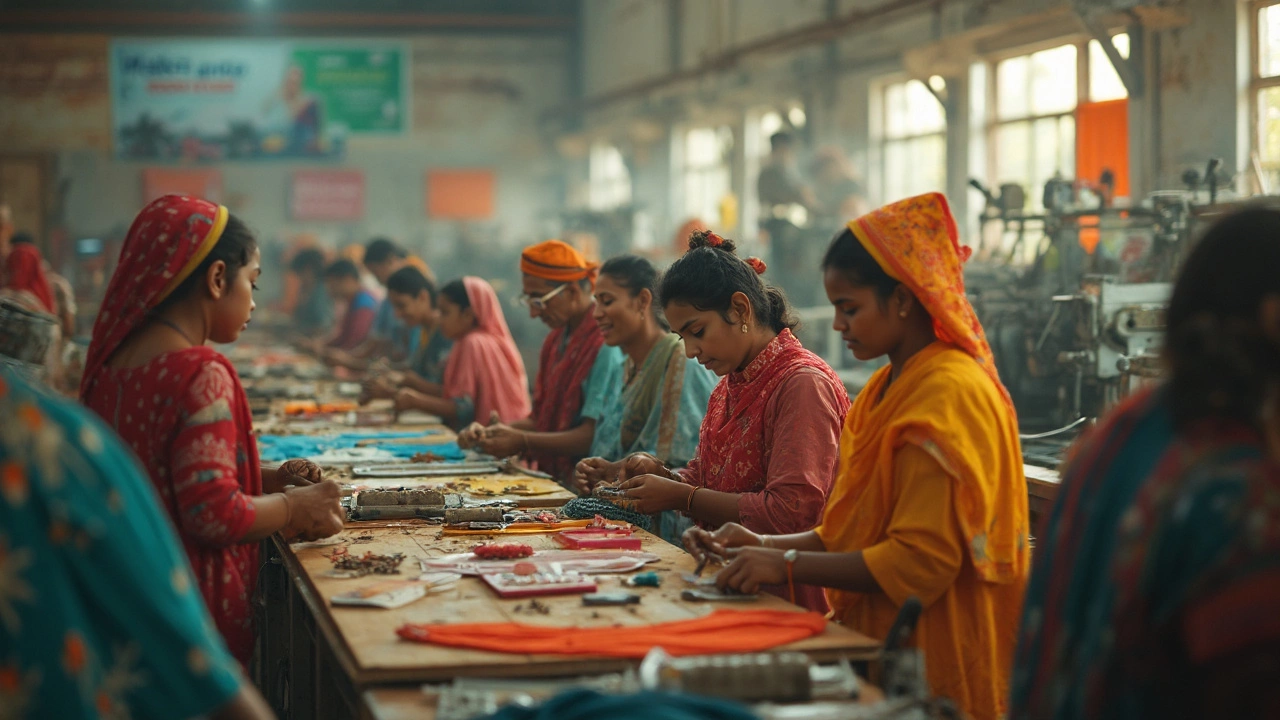Most folks hear 'local manufacturing' and think it just means making stuff in your own country, but there’s a lot more going on. It actually shapes what we buy, where our jobs come from, and how much control we have over the things we use daily—right down to the phone in your hand or the shirt on your back.
Ever wondered why the government keeps pitching schemes like 'Make in India'? It’s not just good PR. Local manufacturing cuts down on imports, saves money, and helps create work for regular people instead of depending on factories halfway across the world. For small businesses and startups, that means way more chances to get a foot in the door, land contracts, and actually grow instead of just surviving.
If you’ve got a family member looking for a job, or you’re thinking of starting something on your own, understanding how local manufacturing works—and how government schemes support it—can actually change your choices. You don’t have to read giant policy books. Just get a handle on what counts as local manufacturing, where the opportunities are, and how real families, like mine and yours, benefit when a simple product gets made down the road instead of shipped from another country.
- Local Manufacturing: Not Just a Buzzword
- How Government Schemes Back Local Production
- Who Really Benefits? Stories from the Ground
- The Ripple Effect: Jobs, Skills, and Small Businesses
- Cracking the ‘Made in India’ Tag: What Qualifies?
- Practical Tips for Getting Involved
Local Manufacturing: Not Just a Buzzword
People toss around the term “local manufacturing” all the time, but it’s way more than a slogan slapped on a product. In simple terms, local manufacturing means making products close to where they’re actually used—right here, inside our own borders, in our own states, often by regular folks from our own cities. That’s very different from global brands shipping finished goods into our markets from far-off places.
For a product to truly count as locally manufactured in India, the key steps of creating it—like assembling, packaging, and final processing—usually need to happen at Indian factories or workshops. It’s not enough if the parts are imported and just glued together here; the heart of the work must be done at home.
There are real perks to keeping production local. For example, the local manufacturing sector in India contributes close to 17% of GDP and employs over 57 million people. That’s not just some stat from the news. These are jobs for our neighbors, friends, and maybe even someone you know personally.
| Fact | Number |
|---|---|
| Jobs Created by Local Manufacturing | 57 million |
| Contribution to GDP | 17% |
| Growth by 2025 (expected) | Over 20% |
Sometimes, government schemes add a little twist to what counts as local. Some programs say that if more than 50% of the value of the product comes from resources and work inside India, it’s considered locally manufactured. This makes things clear for both big companies and tiny workshops.
Why should you care? First, local manufacturing gives us better control over quality and safety. Second, it puts our money back into the communities where we actually live, bringing real change you can feel when someone in your family, or your neighborhood, lands a steady job in a new factory.
The story’s bigger than just pride, though. When COVID-19 hit, India’s ability to churn out its own medical gear and pharmaceuticals came in handy, cutting down on costly imports and delays. That’s local manufacturing in action—making sure we’re not left waiting when it counts.
How Government Schemes Back Local Production
If you’ve ever read about India’s push for self-reliance, you’ve seen this in action. The government doesn’t just talk about local manufacturing; it puts serious money and resources behind it. Big policy names like 'Make in India', 'Production Linked Incentive (PLI)', and programs for MSMEs (Micro, Small and Medium Enterprises) are all geared toward powering up homegrown industries.
Here’s how these major schemes help:
- Make in India: Started in 2014, its goal is simple—turn India into a global manufacturing hub and cut down on imported goods. It encourages companies from around the world to manufacture their products in India, but also supports Indian firms through easier regulations and cheaper loans.
- PLI Scheme: This one gives direct cash incentives to manufacturers that make more goods locally, especially in electronics, pharma, and auto parts. If they meet local production targets, the cash keeps coming.
- MSME Support: Small businesses don’t get left out. The government offers subsidized loans, training programs, and even helps with digital sales so local producers can compete with bigger players.
Here’s a snapshot of the impact these programs have had in the past year:
| Scheme | Year Launched | Jobs Created (2023-24) | Funds Allocated (INR crore) |
|---|---|---|---|
| Make in India | 2014 | 64,000+ | 3,000 |
| PLI Scheme | 2020 | 75,000+ | 13,000 |
| MSME Support | Ongoing | 32,500+ | 22,138 |
One cool thing: If you set up a factory for mobile parts in Noida or a small furniture shop in Pune, you might get tax breaks or help getting land. For folks just starting, these government policies can be the difference between giving up and getting things off the ground.
The point is, these schemes aren’t just fancy commercials. They are opening up doors for thousands. Keeping an eye out for the next scheme launch or update can actually give your business a real boost, especially if you are looking for funds or thinking about jumping into manufacturing yourself.
Who Really Benefits? Stories from the Ground
Here's where things get real. When you hear about local manufacturing, it's not just about factories or slogans—it's about people whose lives change in big or small ways. Let me lay out what this looks like on the ground, not in fancy reports but in everyday life.
Small businesses, workers, and even families are the first ones to see the difference. For example, take the story of Ramesh, who runs a tiny machine parts shop in Pune. He used to get just one or two orders a month before government schemes encouraged bigger companies to buy locally. Now, he's hiring two extra people and even thinking of upgrading his machines. His case isn’t unique. Thousands like him across India are seeing real change.
It's not just about owners. In Tamil Nadu, a textile factory that switched to sourcing all its cotton locally under the MSME scheme managed to keep jobs safe during the COVID-19 lockdowns. According to government data, nearly 1.2 crore jobs were created through MSME ministries’ schemes between 2019 and 2024. That’s not just a statistic—that’s more school fees paid, loans closed, and actual meals on the table.
So, who’s actually benefiting? Here’s a simple breakdown:
- Workers: More local production means more local jobs—both skilled and unskilled. A survey by Invest India showed a 34% jump in jobs in regions focused on Make in India policies in 2023.
- Entrepreneurs and MSMEs: Lower transport costs, quicker payments, and more government tenders going to small producers instead of multinational giants.
- Local economies: When profits stay in the region, small towns grow faster. It’s easier for families to find work close to home, and more kids stay in school since parents aren’t forced to migrate for work.
- Women: Schemes like Pradhan Mantri Mudra Yojana support women-led businesses, and data from 2024 showed that 30% of all Mudra loans went to female entrepreneurs, especially in handloom and food processing sectors.
Here’s some hard data that shows real movement:
| Group Benefited | 2019 | 2024 |
|---|---|---|
| MSME Employment (crore) | 11.1 | 12.3 |
| Women-led MSMEs (lakh) | 81 | 115 |
| India's Manufacturing GDP Share (%) | 14.7 | 17.8 |
Long story short: when the government actually pushes local manufacturing, you don’t just see new buildings or machines. You see families finding jobs nearby, small business owners like Ramesh expanding, and women getting the funds to launch businesses of their own. It puts real power, and real income, back in regular people’s hands.

The Ripple Effect: Jobs, Skills, and Small Businesses
When people talk about local manufacturing, they’re not just talking about what gets made—they’re talking about jobs, skills, and real growth for small businesses. Let’s break down how this actually plays out in day-to-day life.
The first big win? Jobs. A report from the Confederation of Indian Industry (CII) shared that every ₹1 crore invested in manufacturing can create up to 30 direct jobs and double that indirectly, including suppliers, transport, and even the chaiwala outside the factory gate. You see this every time a new plant opens in a small town and suddenly everyone’s uncle or friend has work.
It doesn’t stop at jobs. Whenever factories and workshops pop up, folks pick up new skills. In India, schemes like Skill India have helped train more than 1.4 crore youth in vocational manufacturing skills since 2015. Welding, CNC machining, electronics assembly—stuff that’s actually useful and pays decent money. When I was growing up, hardly anyone in our extended family thought about becoming a machine operator or starting a unit. Now, it’s a real plan, not just a distant dream.
Small businesses thrive, too. According to the MSME Ministry, over 63 million small and micro businesses operate in India, and a huge chunk of them supply parts, tools, or services to bigger companies. When the government rolls out schemes like Production-Linked Incentive (PLI), it’s not just the big fish who win. Smaller players get contracts, steady orders, and a bit of breathing room to actually invest in better equipment or more staff.
| Impact Area | Numbers/Stats | Source/Year |
|---|---|---|
| Direct Jobs Created per ₹1 crore investment | Up to 30 | CII Report, 2023 |
| Youth Trained in Manufacturing Skills | 1.4 crore+ | Skill India, 2015-2024 |
| Total MSMEs in India | 63 million+ | MSME Ministry, 2024 |
What does this mean for you? Maybe your cousin lands a secure operator job, or your friend finally gets enough orders for his welding shop to hire a helper. More local manufacturing means more chances for people like us—not just a better bottom line for big companies.
Cracking the ‘Made in India’ Tag: What Qualifies?
Everyone tosses around the ‘Made in India’ tag, but not all products stamped with it actually mean the same thing. There are rules—some strict, some a bit grey. So, what does it take for something to really qualify as made locally?
The local manufacturing label is all about how much of the product is actually put together in India. According to the Department for Promotion of Industry and Internal Trade (DPIIT), at least 50% of the value of goods should come from within the country for it to count as ‘Made in India’. That means materials, labor, packaging, and processing need to be sourced right here, not just imported and quickly assembled.
Let’s get concrete. If you’re making shoes, this means the leather, the workforce, and most of the finishing touches happen here. If you’re only sticking on a label or screwing on a handle to an imported product, that doesn’t make the cut in official government eyes. Got a tech gadget? At least half of all components and that final assembly must happen in India.
- Raw Material Sourcing: Using Indian materials counts directly toward qualifying your goods.
- Local Labor: Employment must happen on local soil—not just quick packaging or simple assembly.
- Value Addition: More of the product’s value has to be created here rather than shipped in nearly finished.
- Compliance: There's a checklist for government procurement. Products must meet these requirements for tenders or benefits.
If you’re a business owner, don’t just slap a sticker on and hope for the best. There are audits, especially if you want to sell to the government. A lot of companies get tripped up here—thinking it’s just a branding trick, but the backend numbers do get checked when money or contracts are involved.
Here’s a quick data snapshot of what goes into calling something ‘Made in India’ officially (as per 2024 government guidelines):
| Product Category | Minimum Indian Content (%) | Government Scheme |
|---|---|---|
| General Goods | 50% | Public Procurement Policy |
| Electronics | 50% | Make in India, PLI Scheme |
| Defence Equipment | 60% | IDDM (Indigenously Designed, Developed and Manufactured) |
| Solar Panels | 75% | Domestic Content Requirement (DCR) |
Remember, just setting up shop in India isn’t enough—most government orders, incentives, and schemes only go to those who follow these rules. If you’re looking to tap into these benefits or just stay on the right side of new rules, it pays to keep the sourcing, labor, and value addition real and balanced here, not just looking local on the surface.
Practical Tips for Getting Involved
Want to be a part of the local manufacturing wave? You don’t have to quit your day job or open a giant factory. There are ways ordinary people, small business owners, and even fresh grads can get started. Here’s a hands-on guide that keeps things real:
- Tap into Government Schemes: The Prime Minister’s Employment Generation Programme (PMEGP), the Production Linked Incentive (PLI) scheme, and MSME registration are actual doors to funding, training, and market access. Visit the government’s MSME portal or your district industries center to get starter info. These schemes are meant for small makers—not just big names.
- Skill Up: Lots of government programs (like Skill India) offer crash courses in basic production, packaging, and even quality checks—often free or super cheap. A single certificate can open doors to factory jobs or help you set up your own workshop at home.
- Find a Niche: Instead of doing what everyone else does, look for gaps. For example, during COVID, local units making masks and sanitizers earned well when others struggled. Think local demand.
- Collaborate with Existing Manufacturers: Many medium-sized players look for suppliers or partner workshops. Start by offering your service (like woodworking, welding, or printing) to bigger units in your city.
- Check Out Credit and Subsidy Options: Mudra loans and Stand-Up India schemes were set up to help you get money without massive paperwork. Don’t ignore state-level options—some states even offer electricity discounts and land at reduced rates for new units.
- Go Digital: Setting up an online store for locally made goods is easier than ever and helps you reach buyers directly. The Government e-Marketplace (GeM) is the official route for selling your products to the government itself—no middlemen.
It pays to keep an eye on success stories. For instance, brick-and-mortar unit owners in Pune used PMEGP grants for machines and now supply parts to auto majors. Even home-based workers in smaller towns, using basic MSME schemes, produce packaging material for big outlets.
Talk to people who’ve cracked it—whether it’s an uncle who started a small welding shop or a neighbor running a tailoring unit. Each one has a story, and most are happy to share the real scoop about applications, hiccups, or government visits.
If you feel lost, drop by the local MSME helpdesk—they’re used to newbies and can walk you through paperwork or grant forms. And if there’s an expo or fair in your town, just go. You’ll spot contacts, fresh ideas, and maybe a future partner for your own local venture.





